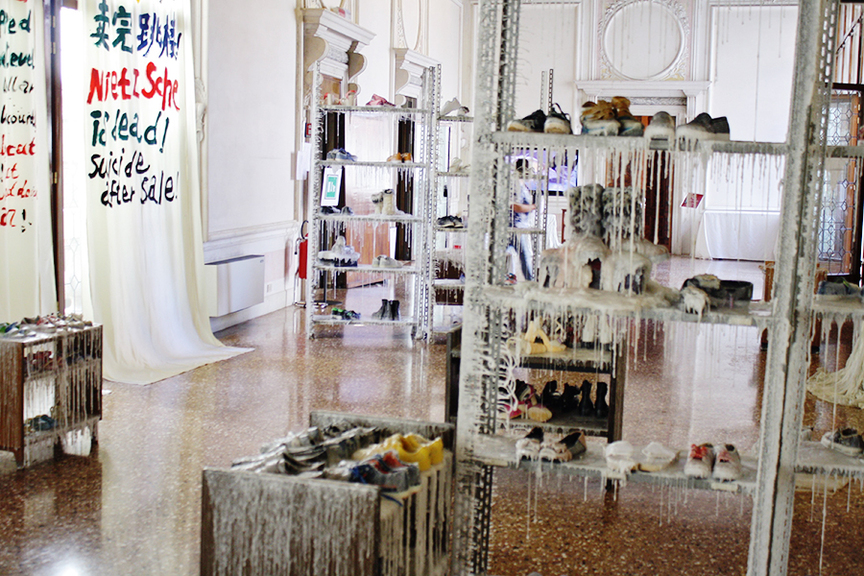“Nietzsche is dead! Suicide after Sale” was written on banners hanging inside the Palazzo Morosini by ZHENG GUOGU and the YANGJIANG GROUP (Sun Qingling and Chen Zaiyan) in their exhibition “The Writings of Today are a Promise for Tomorrow.” This series, entitled “Last Day–Shop of Frozen Entities,” consists of the inventory of an actual, bankrupt shoe shop whose merchandise they sealed in wax.
“The Writings of Today are a Promise for Tomorrow” was in part a survey of ZHENG GUOGU and the YANGJIANG GROUP. Here, surrounded by inflatable balls written with quotes from Das Kapital (1867), a video screen plays footage of the artist hanging around in the streets of his hometown.
At the Palazzo Contarini Polignac, near the Accademia bridge in Dorsoduro, is a large exhibition featuring the Korean monochrome painters known collectively as Dansaekhwa, organized by the Brussels-based Boghossian Foundation and galleries Kukje (Seoul) and Tina Kim (New York). Here, LEE UFAN combined his painting and sculpture practices to create this newly commissioned work on the garden floor.
Upstairs at the Dansaekhwa exhibition were individual rooms for its featured artists. Seen here are ink abstractions by the late KWON YOUNG-WOO (1926–2013).
Baku-based Yarat organized an exhibition of its own at the Palazzo Barbaro, entitled “The Union of Fire and Water,” which brought together ALMAGUL MENLIBAYEVA and RASHAD ALAKBAROV, who created works about historical connections between Venice and Baku. The former resident of the Palazzo Barbaro, Giosafat Barbaro, was the Venetian ambassador to the Turkic regions of the Persian empire in the 15th century. Menlibayeva’s film cycle “Fire Talks to Me” (2015) is displayed in different rooms throughout the palazzo, relating to the iconography of the individual spaces, and depicting scenes from the first Muslim opera Leyli and Majnun set in industrial oilfields of the Caspian.
Sharing the Palazzo Barbaro was RASHAD ALAKBAROV, whose iron sculpture of playing cards Precariousness of History (2015) were emblazoned with the names and dates of regional wars and their fallen leaders from throughout history.
AHMET GÜNEŞTEKIN’s exhibition, organized by New York’s Marlborough Gallery, shows off the Turkish painter’s which takes inspiration from Byzantine Emperor Constantine’s obelisk known as the “Million Stone.” There is also an enormous sculpture reading “Kostantiniyye” in Robert Indiana-like lettering, emblazoned with all the historical names of the city now known as Istanbul.
“In the Eye of the Thunderstorm” was organized by Contemporary Practices Art Journal, and is a group show of Arab artists, including Baghdad-born MAHMOUD OBAIDI, whose project comprises paraphernalia from a fictitious Middle Eastern dictator.
Organized by the Shanghai Himalayas Museum, “Humanistic Nature and Society (Shan-Shui)–An Insight into the Future” features this nighttime composite video, in the Chinese landscape-style, by YANG YONGLIANG.
The Faurschou Foundation organized a surprisingly good survey of LIU XIAODONG’s paintings, “Painting as Shooting,” curated by Jèrôme Sans, at the Fondazione Giorgio Cini on the Island of San Giorgio Maggiore. Hot Bed No. 2 (2006), on the left, depicts Bangkok prostitutes when they are off the job, while Out of Beichuan (2010), on the right, captures local girls in a village just after it was wrecked by the 2010 Sichuan Earthquake.
Nearby at the Fondazione Giorgio Cini is HIROSHI SUGIMOTO’s Glass Tea House Mondrian, which debuted in 2014 during that year’s Venice Architecture Biennale, and is inspired by “pre-modern” abstraction.




